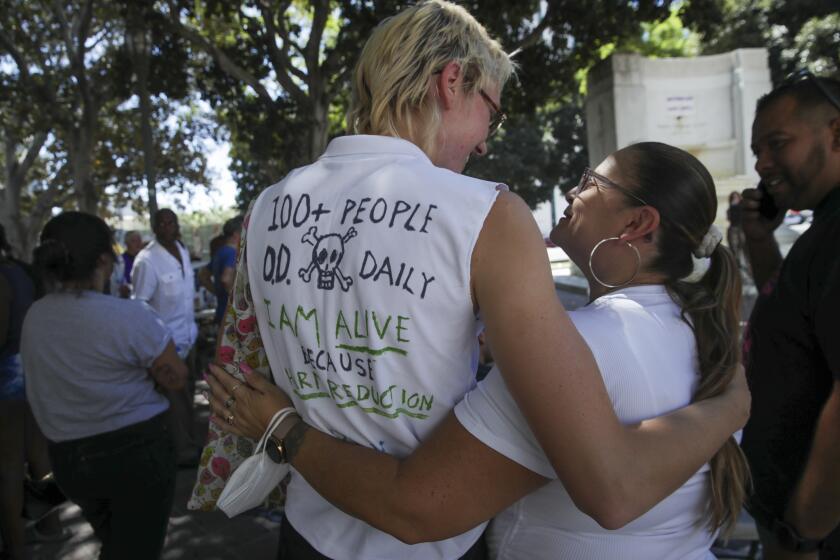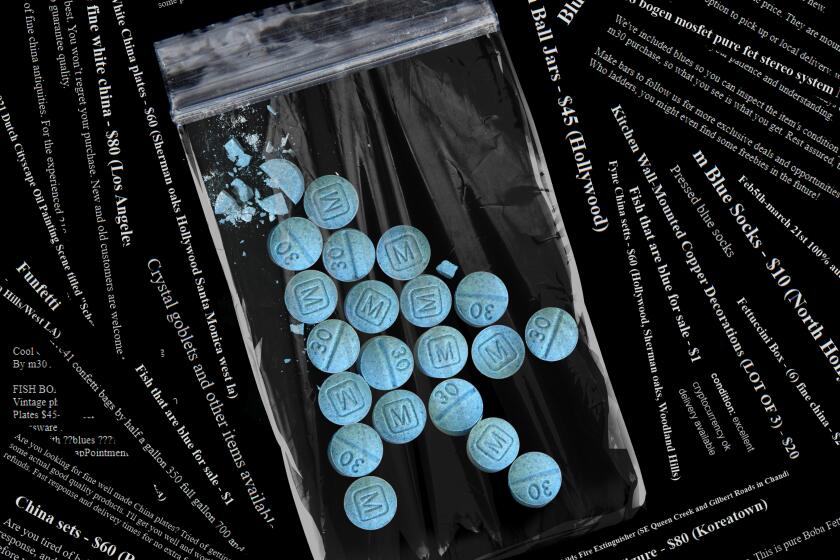Newsom touts California efforts on fentanyl at the border. Will it matter to Trump?

- Share via
- Despite recent efforts, U.S. ports of entry near San Diego remain a route for smuggling illicit fentanyl across the border.
- Fentanyl is a key issue for both Gov. Gavin Newsom and President-elect Donald Trump, who will soon oversee federal agencies tasked with border and drug enforcement.
- On Thursday, Newsom promoted California’s contribution to a new port of entry being built at Otay Mesa while continuing to tout state efforts to crack down on drugs at the border.
Each day, thousands of people drive or walk into the U.S. from Tijuana at Otay Mesa, a port of entry that is one of the most fortified and closely watched border checkpoints in the world. And yet one way or another, fentanyl keeps pouring through.
In recent years, the crossing and another at San Ysidro a few miles west have played a key role in America’s addiction crisis. Federal border authorities in San Diego seized about 11,400 pounds of illicit fentanyl last fiscal year, much of it at Otay Mesa.
Although seizures were down near San Diego in 2024, according to U.S. Customs and Border Protection, the agency still routinely busts vehicles headed north up the 5 Freeway with thousands of cartel-produced counterfeit pills concealed in the doors and wheels, or mixed with imported merchandise inside shipping containers.
Federal prosecutors allege Jasveen Sangha, one of five people charged in actor Matthew Perry’s death, was known by another name: “Ketamine Queen.”
Fentanyl and the border are key issues for Gov. Gavin Newsom as he attempts to navigate relations with President-elect Trump, who has blamed Democrats for failing to get tough on smugglers. Come January, Trump will once again oversee CBP and other federal agencies tasked with immigration and drug enforcement. Federal funds help support state efforts, and local agencies often coordinate with national counterparts on investigations or in response to major incidents.
So far, Newsom has tried to thread the needle, promoting the economic benefits of trade with Mexico through California while continuing to tout state efforts to crack down at the border.
On Thursday, the governor traveled to San Diego County to announce a road project to carry drivers to a long-delayed additional border crossing called Otay Mesa East, being built about two miles from the main port of entry.
During the visit he also trumpeted a California National Guard initiative his office said would “enhance border security” by “building on the state’s fight to curb the flow of fentanyl by targeting the guns and cash that flow south and further fuel cartel profits and violence.”
Standing in front of a section of towering, rust-colored border wall, Newsom announced plans to boost the number of California National Guard members supporting federal border enforcement efforts.
“We’re going to increase that operation,” Newsom said, adding that some state forces are already deployed, including a group of uniformed soldiers who stood nearby as he spoke.

Despite rhetoric from Trump that an “immigrant invasion” is underway, the reality is that it has become tougher than ever to enter the country illegally.
This year, the Biden administration all but eliminated a path to political asylum for those who attempt to cross the border without papers. That’s resulted in a precipitous drop in border encounters nationwide, from the peak of 370,000 in December 2023 to 205,000 in June, according to CBP data.
Fentanyl overdoses appear to be on the decline and seizures of the drug by CBP’s San Diego field office fell by half last fiscal year to 5,700 pounds, according to the federal agency. Trump and his supporters have attempted to link drugs to migrants, but data show that U.S. citizens accounted for 80% of individuals caught with fentanyl during border crossings at ports of entry from 2019 to 2024.
U.S. deaths due to drug overdoses fell last year, the first decrease in five years, according to estimates by the Centers for Disease Control and Prevention.
Vanda Felbab-Brown, a senior fellow at the Brookings Institution, said busy ports of entry such as Otay Mesa are prime smuggling corridors because it’s impossible for authorities to scour every single semi-truck laden with produce, electronics, vehicles, and other goods from Mexico.
“You have legal trade going through legal ports and if you search every vehicle you’ll have no trade,” she said. “It’s a fantasy that you can have total inspection.”
A bipartisan immigration bill that died in Congress this year at Trump’s urging would have provided millions of federal dollars to greatly increase the number of vehicles crossing the border that authorities could inspect. But even that wouldn’t stop cartels from flooding the U.S. with fentanyl, Felbab-Brown said. It’s simply too lucrative of an enterprise.
“Before that bill, the U.S. was capable of checking about 2% of personal vehicles and 20% to 30% of trailer trucks,” she said. “If it was fully funded, they would get to 70% of trailer trucks and maybe 20% of personal vehicles.”
On Thursday, Newsom heralded progress on Otay Mesa East, which is expected to open in December 2027.
Also known as Otay II, Newsom’s office said the new crossing will have major economic benefits and “has the potential” to reduce wait times at the border by half.
The crossing was supposed to be ready as soon as 2026, but Newsom said negotiations over its operation and the revenue it will generate via tolls have been the main culprits for extensive delays.
Newsom also said in his Thursday remarks near the border wall that the state has “applied with the U.S. State Department to formalize a National Guard partnership very similar to the one we have in Ukraine,” with the troops providing support and training to Mexican forces.
Whereas other sites and apps almost eliminated drug postings after scrutiny by law enforcement, dealers on Craigslist seemingly remained active using code words.
Bill Bodner, former special agent in charge of the Drug Enforcement Administration’s Los Angeles field division, said he supports redirecting personnel and other resources from other areas of the country to the southern border, where the vast majority of fentanyl is smuggled into the U.S.
But there’s only so much the state can do, Bodner said. Ultimately, it’s up to federal authorities to police the border and enforce immigration laws — and billions in tax dollars are already spent on those efforts.
“I’m not a big fan of all these working groups and ad hoc task forces,” Bodner said. “The resources are there already. … It’s a matter of letting people do their jobs.”
More to Read
Sign up for Essential California
The most important California stories and recommendations in your inbox every morning.
You may occasionally receive promotional content from the Los Angeles Times.













